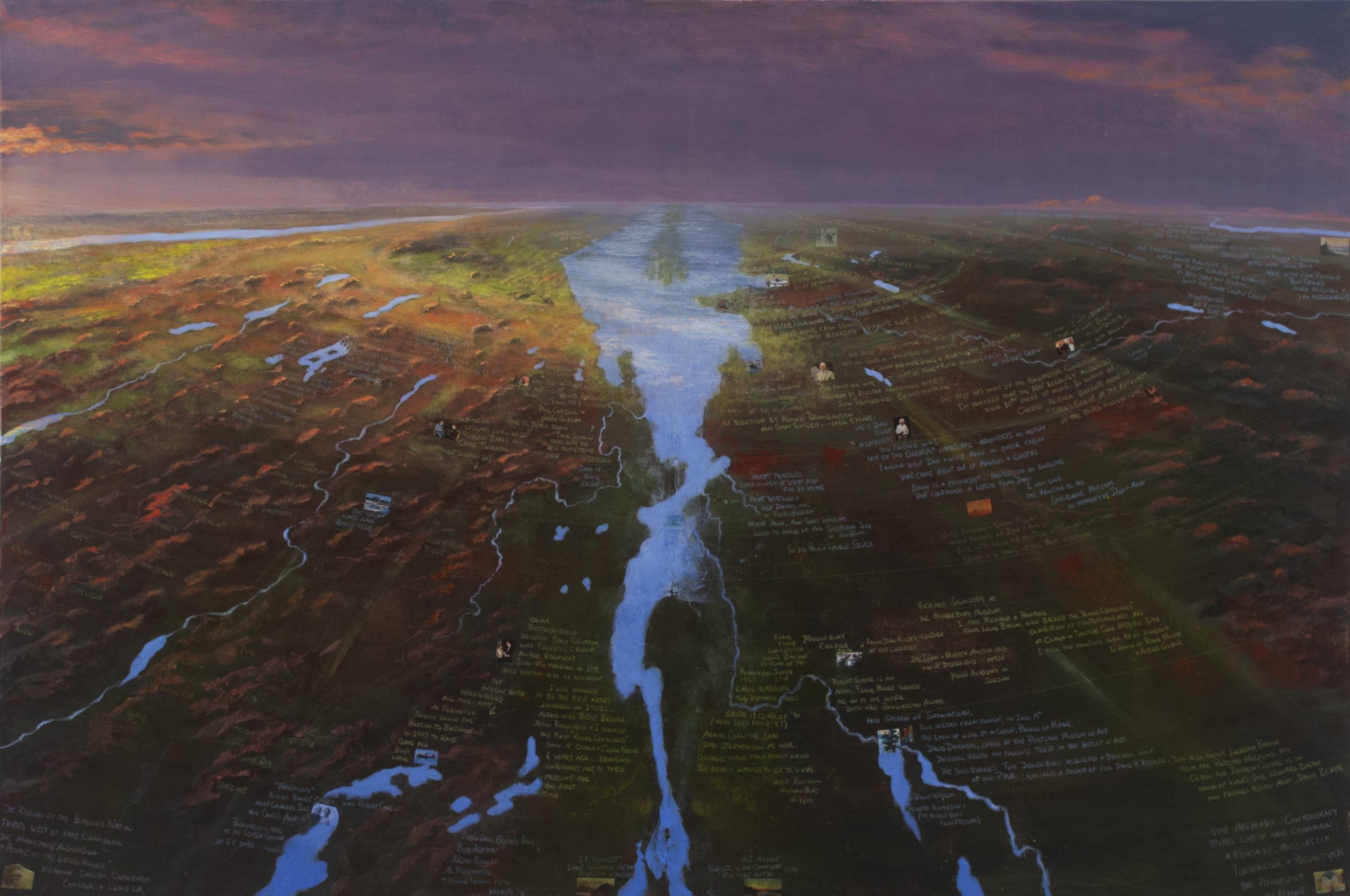FOR IMMEDIATE RELEASE
Contact: Kristen Levesque
(207) 329-3090
kristen@kristenlevesquepr.com
Shelburne Museum Acquires Paintings by Nationally Recognized Contemporary Artist Stephen Hannock

SHELBURNE, Vt. (August 9, 2021) — Shelburne Museum is pleased to announce that it has acquired a major work by nationally recognized contemporary painter Stephen Hannock, best known for his large-scale atmospheric landscapes. The painting entitled
A Recent History of Art in the Champlain Valley (Mass MoCA #333) is on view in the museum’s Webb Gallery of American Art.
“We are delighted to add this remarkable view of our region to the Museum’s collection of American paintings,” said Director Thomas Denenberg. “Stephen Hannock’s work carries forward the collecting ethos of our founder Electra Havemeyer Webb who not only gathered a remarkable assembly of 19th-century works by artists like Thomas Cole, Albert Bierstadt, Fitz Henry Lane and Winslow Homer, but also ensured that the contemporary vision of an Andrew Wyeth found a home at Shelburne Museum.”
A Recent History of Art in the Champlain Valley (Mass MoCA #333) depicts a large-scale, birds-eye view of Lake Champlain and the surrounding region and includes features such as New York’s Adirondack High Peaks region to the west, and the distant border between Vermont and New Hampshire, defined by the Connecticut River, to the east. In between are notable geographic features, collaged elements, and inscriptions that link the work to place, time and its maker’s biography. Hannock wrote of the painting, “with the appreciation of a given place or landscape comes the daydreaming that embraces past experiences as well as possible adventures in the future … Beginning with my daughter’s admission to the University of Vermont in the fall of 2018 I set out to compose a vista-with-text to celebrate some of the personal and cultural history that I have been privileged to experience in eastern New York and western New England.”
 The artist has also presented the museum with a second, smaller work created in 1993 titled Red Nocturne. Filled with the light of a glowing coral sunset, Red Nocturne was created when Hannock used a cast-off envelope to soak up extra paint on the surface of one of his in-process canvases. When the envelope was pulled away from the picture’s surface, he called the impression a “palimpsest,” or an object that is reused or altered but still bears traces of its earlier form. A small reproduction of Red Nocturne is visible near the center of A Recent History of Art in the Champlain Valley (Mass MoCA #333).
The artist has also presented the museum with a second, smaller work created in 1993 titled Red Nocturne. Filled with the light of a glowing coral sunset, Red Nocturne was created when Hannock used a cast-off envelope to soak up extra paint on the surface of one of his in-process canvases. When the envelope was pulled away from the picture’s surface, he called the impression a “palimpsest,” or an object that is reused or altered but still bears traces of its earlier form. A small reproduction of Red Nocturne is visible near the center of A Recent History of Art in the Champlain Valley (Mass MoCA #333).
Hannock’s singular technique—extensive layering of color and collage elements, as well as polished surfaces that have been buffed to a dreamlike sheen—make each painting, no matter its size, instantly identifiable. This multi-layered approach to painting invokes the landscapes of Thomas Cole, the stage-like settings of the pre-Raphaelites and the sweeping panoramas and mise en scène in the films of Alfred Hitchcock. Hannock describes his approach to image-making as reinventing vistas, which take on new forms and atmospheres through his painting. He is drawn to the way mood is composed within the work to create a story that is literally written into the fabric of the piece. Hannock’s addition of diaristic texts and photographic images to the mountains, trees and fields comprises his unique contribution to 20th-century landscape painting. Hannock, in essence, interrupts the realism of his landscapes, transforming them into self-portraits.
Hannock’s work can be found in public collections throughout the United States and Europe, including The Metropolitan Museum of Art, New York; National Gallery of Art, Washington, D.C.; Whitney Museum of American Art, New York; Museum of Fine Arts, Boston; Museum of Contemporary Art, San Diego; Museum of Fine Arts, Houston; and Yale University Art Gallery, New Haven; among others. He currently lives and works in North Adams, Massachusetts.
Image Captions:
- Stephen Hannock (Williamstown, Massachusetts, b. 1951) A Recent History of Art in the Champlain Valley (Mass MoCA #333), 2021. Polished mixed media on canvas. Museum purchase, made possible by a gift from Todd R. Lockwood, 2021-7 © Stephen Hannock.
- Stephen Hannock, Red Nocturne, 1993. Mixed media on postcard, 3 5/8 x 5 1/8 in. TC2021-16. © Stephen Hannock.
Hi-res images available HERE.
About Shelburne Museum
Founded in 1947 by pioneering folk art collector Electra Havemeyer Webb (1888–1960), Shelburne Museum in Shelburne, Vermont, is the largest art and history museum in northern New England and Vermont’s foremost public resource for visual art and material culture. The Museum’s 45-acre campus is comprised of 39 buildings including the Pizzagalli Center for Art and Education and Webb Gallery featuring important American paintings by Andrew Wyeth, Winslow Homer, Grandma Moses, John Singleton Copley and many more. For more information, please visit shelburnemuseum.org.
###

